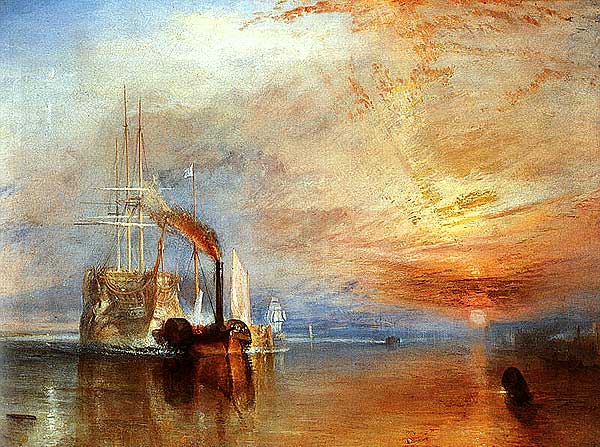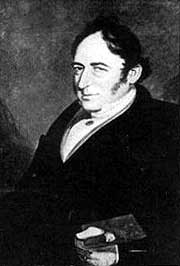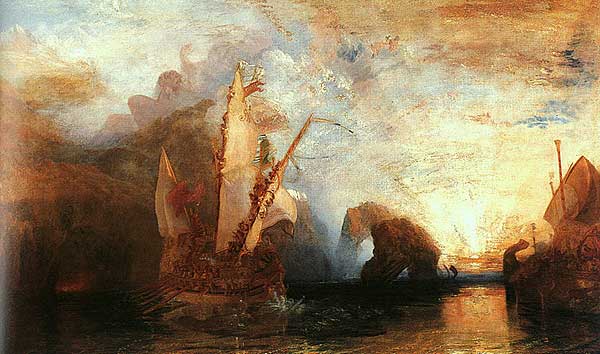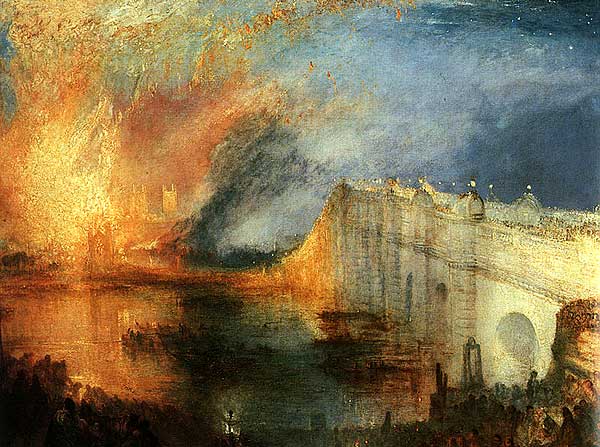Dear Artist,
Depending on your point of view, he was either one of the world’s most important painters, or the original amateur. J. M. W. Turner (1775-1851) influenced many artists, particularly the impressionists. (Monet and Pissarro were knocked over by his work) His paintings of luminous vapor have etched their way into the popular imagination.
One magic day years ago I stood in front of the real stuff at the Tate in London. Ever since then I’ve been wired for Turner — both the artist and the art. I always feel I owe him a visit.
He was the son of a Covent Garden barber and an “unstable mother.” Through his compulsive and legendary miserliness he rose to great wealth. A “boy wonder,” he worked in both watercolour and oil. He traveled regularly and with purpose, read widely and became a student of everything that came his way. While early elected to the Royal Academy, he avoided the politics but stayed a lifelong member. Turner spoke poorly, lectured inaudibly and socialized infrequently. At the same time he cultivated the gentry, paid little attention to critics, pushed his prices ever higher and sold most of his work from his home gallery. He sometimes included his own poems with his paintings. In his maturity he became “a painter of light” — his critics would say, “a painter of nothingness.” His subject matter, while land and seascape based, spoke deeply of the human condition, universal laws, solitude, the power of nature over man. On the cusp of the Industrial Revolution, he also tackled Classical and Biblical themes. He was a quick study. Cannily, he bought back what he thought were his better works. A shabby misfit in later life, he let his Chelsea home and his paintings deteriorate around him. He sealed his immortality by stockpiling his better works and leaving them to the Nation.
The old masters were Turner’s masters. At various times he worked in the style of Claude, Poussin, Rembrandt, Willem van de Velde, and others. “This made me an artist,” he said in a typical one-liner. Turner was a man who challenged himself to match and excel. To him art was a lineage and he was meant to be part of the line.
Best regards,
Robert
PS: “I was introduced today to the man who beyond all doubt is the greatest of the age; greatest in every faculty of the imagination, in every branch of scenic knowledge; at once the painter and the poet of the day.” (John Ruskin) “Light is colour.” (Turner) “Art is a rum business.” (Turner)
Esoterica: Turner was noted for arriving at Academy shows on “Varnishing day” and reworking his paintings, sometimes massively, in order that they might outshine the nearby competition. It seems he had little regard for “fat over lean” or other proper conventions — he often laid fugitive glazings over earlier varnishes, which has made for a restorer’s nightmare.
J. M. W. Turner (1775 – 1851)
Handling watercolours at the Tate
by Neeman (Neil) Callender, Safat, Israel
The best-kept secret of the Tate Britain is their Turner Bequest. The Prints and Drawings Rooms allow you to choose boxes of his watercolors to view in a library setting. All you need do is call for an appointment and you look at boxes and boxes of his watercolors. I have had the indescribable pleasure of sitting for an eight-hour day examining Turner watercolors. And the next day, another eight hours examining watercolors of John Sell Cotman, Thomas Girtin and David Cox. There is nothing like holding the watercolors of Turner close to you!
Turner Exhibition in the USA
by Bob Scott, Washington, DC, USA
An important Turner show is happening right now in Fort Worth, Texas at the Kimbell Art Museum. “Turner and Venice” runs through May 30, 2004. The museum says that this is “the first Turner exhibition of such scale and importance to be seen in the United States since 1966.” I’ve been angling to get there, but life is not so simple.
Linear model now suspect
by oliver, Austin, TX, USA
Art may have been lineage and a rather stately orderly progression of ideas with only infrequently more than one line developing and flourishing at any time. With the increasing rapidity of communication — oh starting I guess with the printing press and most recently the internet with nearly instantaneous world wide communication — including visual images I’m not sure that the linear model holds sway. Too much cross-pollination between the many trends, media, styles that are currently flourishing.
Far reaching Turner influence
by Jiqun Chen, Mongolia
I have liked Turner’s work from since I was very young. East Ujumchin is famous for its rich water resources and fertile pastures. The annual average temperature is below 0 (C), which is well suited for raising livestock. Cultivation of land was forbidden throughout history until 1969, when the Ulagai Cultivation District was established. After then, large areas of land began to be cultivated with great damage to the environment. After graduation from the Art School attached to the Central Academy of Fine Arts, I went to Ujumchin as an educated youth along with 400 middle school graduates from Beijing. I lived in Mantugbolog, East Ujumchin for 12 years. The vast and beautiful prairie and the peaceful Narin (Narrow) River has been the constant destination of my dreams.
Grew up with a Turner
by T. V., Athens, Greece
During my childhood, there was what everyone thought was a Turner over the fireplace in our home. My grandfather bought it during his wealthy days in New York at an auction. We had a lot of paintings and art in our home — given to us from my grandfather… It was funny growing up in a simple house with these huge famous paintings in the living room. My grandfather always said it was a Turner. It even had a plaque on the frame. It looked a lot of what one would expect from a Turner. The Tate had a hard time telling us if it was authentic — they weren’t sure. Sothebys said it probably wasn’t. It’s a mystery that I don’t think we will ever solve. I studied art at Skidmore and later the School of Visual Arts in New York and the Art Students League. I work in ceramics, marble and wood and have done a big project for the airport in Dubai.
I saw a Turner sky
by Mary Jean Mailloux, Oakville, ON, Canada
Early one evening, while on a recent trip “across the pond,” my eyes were arrested by an endless stretch of golden yellow cumulus clouds undulating for miles just above the Lancashire moors. This vision was typical of a Turner interpretation, and I could see how the master was inspired to make the clouds both yellow and golden and often the most dramatic part of his paintings. The sight was even more poignant because it occurred after a drab, rainy day, so typical of Lancashire, and just outside a mill in one of Britain’s industrial towns. I wondered then if the locals saw such splendor everyday and failed to notice it. I wondered if this had occurred at home would I have seen it. People informed me that there was nothing of interest to see in this little town. Yet I knew all too well that it takes time to really see. Seeing is in itself an art. Each time I paint en plein air people stop and look at what I’m doing. Then they look at the subject of my work and they tell me they had not seen that house, or that flower, or that tree or that person in that light. Perhaps that is what art is, the crystallization of a vision.
Magic in his pocket
by Mary Madsen
I’d seen many Turner paintings in books and wasn’t all that impressed. They looked messy and confused. Then I was at the Huntington Library in Pasadena, California, going through the main building, when I came around a corner, and there, unexpectedly, was a Turner. I didn’t recognize it as a Turner at first, nor was I capable of recognizing anything else around me! The painting literally took my breath away and made the world go a bit wonky. It was like my sensibilities had been hit by a truck. I’m sure the guards thought I was on leave from a mental hospital, because I kept going back around the corner and popping back in front of the Turner, just to make sure it wasn’t the element of surprise that had struck me so profoundly. Nope. It was Turner.
Now I use Turner’s watercolors as my guide. Whenever I finish a watercolor and say to myself, “You’re coming along nicely, lady,” I look at a Turner to remind me how much further I have yet to travel. Magic lies at the end of the road of mastery, but somehow Turner traveled that road with magic in his pocket.
Turneresque artist
by Lillian Tkach-Matisons, Calgary, AB, Canada
At an art show two years ago, a client complimented me on my work and said it was “very Turneresque.” I accepted the compliment graciously, but was surprised and baffled at the remark. As far as I knew, Turner painted “burning ships” and I was painting memories of moody, foggy landscapes and romantic sunset panoramas. Later I found the book Turner by Michael Bockemuhl (published by Taschen) and understood my client’s generous reference. Not only was Turner one of the most prolific artists of our time, he was able to capture the drama, movement and pure color of his subject with confident, loose brushstrokes. Turner’s paintings have inspired me to take more chances, dig deeper, and push further in my quest to paint the memories that have inspired my work.
Turner my teacher
by Valerie McCaffrey, Beverly Farms, MA, USA
I, too, stood in front of a Turner exhibit at the Tate and the oils and watercolours were inspiring, but even more so were his sketchbooks. Pouring over them I saw how Turner drew figures as little pear-shapes with arms and legs in gesture and have been doing so ever since. I tell my students that Turner taught me how to sketch figures.
Not telling anyone where it is
by Joan Rieveley, Windsor, ON, Canada
Two years ago we stayed at a B & B in England. The walls were all filled with art, good, bad and indifferent, every corner, floor to ceiling. The first morning we arose to go to breakfast and upon entering the dining room, I was aghast. There, in front of me was an original Turner, tucked away in a corner. This was a gift to the family from Turner many years ago and had been passed down in the family. They covet the work and asked me not to tell anyone as they are positively not interested in parting with it. They said that visitors tended not to notice it. For us it was a special treat. I will not tell anyone where it is though.
Turners in Edinburgh
by Willa McNeill, Matthews, NC, USA
Several years ago, our Jack Richeson Company sponsored a Zoltan Szabo workshop in Scotland that included a day in Edinburgh. Scheduled in that outing was an appointment at the museum to go into the archives. There we were treated to many Turner paintings without even a sheet of glass between us. We were all blown away with the experience.
Needs a better understanding of Turner
by Peter Trent
You have an ideal opportunity to educate many of us who would seem to be unable to understand clear English! You comment on Turner’ work, and indeed, it is awesome. Like you, I too have admired his works in London’s museums and have wondered at his vision and his technical skills. When, however, you comment on his paintings ‘speaking deeply of the human condition, universal laws, solitude and the power of nature over man’ you completely lose me (and, dare I say it, probably many others). Because this kind of commentary, without supporting illustration (similar to the sort of thing one reads in contemporary ‘Art’ magazines), assumes that the reader has the same depth of understanding as does the commentator, it leaves many who do not, to hold the view that art critics and commentators are ‘elitist’, because their comments do not educate the reader, only state their own bias and if one cannot see, one is culturally blind.
You would do many of us a great service if you would, in another letter, or letters, discuss, in some detail, what you see in Turner’s work that makes you make the comments that you have. I, for one, am eager to have a better understanding of, and a different perspective on, the great works. It can do nothing less than open my eyes to a new way of seeing things and, as an apprentice artist myself, it is something that I need to do on a daily basis.
(RG note) I apologize. Perhaps the Turner letter was a little thicker than usual. Because Turner is so close to my heart and there is so much that can be said about him and his work, as I was writing it I was conscious of condensing a lot of loose ends and broad opinion into the chosen format. The last thing I want to do in these letters is to drop into any kind of “artspeak” or obfuscation. Some of my inexplainable gushing needs to be contained. Bad Bob. A wise, well-illustrated book for anyone who seeks a clear and insightful Turner education is The Art of JMW Turner: A celebration of one of the world’s most influential artists, by David Blayney Brown.
Disciplined writing every morning
by Norah Bolton, Toronto, ON, Canada
I never get the feeling that your writing is taking you away from the making of paintings. I enjoy keeping in touch with someone who is doing both in combination and reminds me that drawing is something I want to get back to, and that just buying more books on painting and drawing isn’t the same as getting down to it! I have acquired the discipline of writing three pages longhand every morning. Your letters are great instruction for living — as well as everything else — and today’s brought back my own delight in seeing the Turners at the Tate for the first time.
Night dancing
by Misha V. Stefanuk
Your letters are the only thing that makes me think that I belong to an artistic community. I am a composer, and even though I have some commercial credits and not a bad income from music, the truth is nobody cares about any of my important music. So that kind of makes one feel quite isolated and pointless. Your letters remind me of Degas’ phrase: “Muses work all day long and then at night get together and dance.”
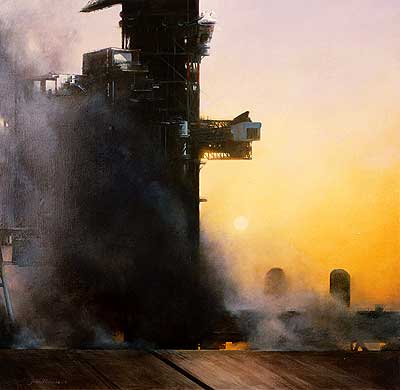
Aftermath, T+60 NASA commissioned oil painting |
You may be interested to know that artists from every state in the USA, every province in Canada, and at least 115 countries worldwide have visited these pages since January 1, 2004.
That includes Jerry Waese who wrote, “Turner paintings are a joy to see — filled with hyper realistic radiance and seemingly constructed by large interacting abstract geometries. The works of men are ephemeral pictured against the everyday grandeur of nature.”
And also William Cranny of Kalamunda, Western Australia who wrote, “Turner was reputed to have said to someone who was having an attack of creative numbness: ‘There’s a sketch at every turn.’ A motivating one-liner for us all when the creative juices seem to have solidified.”


